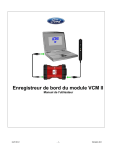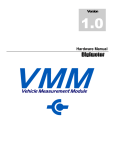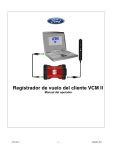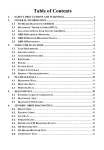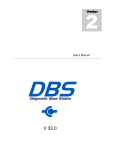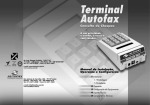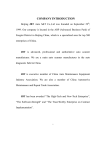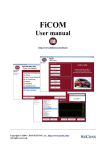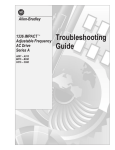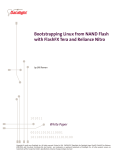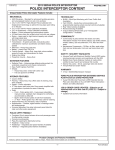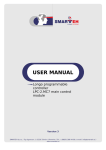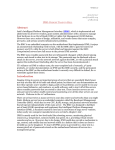Download Vehicle Data Recorder - Motorcraft Technical Resource
Transcript
Vehicle Data Recorder Operator Manual 078-00333 Rev2.0 Trademark Acknowledgements Snap-on is a registered trademark of Snap-on Incorporated. Ford® is a registered trademark of Ford Motor Company. Copyright Information VDR Operator’s Manual ©2008 Snap-on Incorporated. ©2008 Ford Motor Company All rights reserved. The information, specifications and illustrations in this manual are based on the latest information available at the time of printing. Snap-on reserves the right to make changes at any time without notice. VDR Operator's Manual Contents Contents......................................................................................................................................................... 1 Definitions, Acronyms, and Abbreviations ................................................................................................ 2 Introduction .................................................................................................................................................. 3 System Components ..................................................................................................................................... 4 Standard Equipment ............................................................................................................................... 4 Safety ............................................................................................................................................................. 5 Proper Installation and Use of this Equipment ....................................................................................... 5 Equipment Precautions ........................................................................................................................... 6 IMPORTANT SAFETY INSTRUCTIONS ........................................................................................... 6 Using the VDR .............................................................................................................................................. 8 Vehicle Identification ............................................................................................................................. 8 Identifying a New Vehicle.................................................................................................................. 8 Manual Vehicle Entry......................................................................................................................... 9 VDR Set-up from IDS .......................................................................................................................... 10 Parameter Selection .............................................................................................................................. 12 Recording Time Set-up..................................................................................................................... 13 Trigger Set-up....................................................................................................................................... 14 Download to VDR................................................................................................................................ 15 Hook-up to Vehicle .............................................................................................................................. 17 Control of VDR/Manually Recording Data.......................................................................................... 18 User Interface (Pendant)....................................................................................................................... 18 Pendant Events and Indicators.............................................................................................................. 20 VDR Upload to IDS ............................................................................................................................. 21 File Naming .......................................................................................................................................... 22 Playback ............................................................................................................................................... 22 Technical Specifications............................................................................................................................. 26 Vehicle Data Recorder (VDR) ............................................................................................................. 26 Environmental Specifications............................................................................................................... 26 Vehicle Communications Link Interface.............................................................................................. 26 VDR Connectors .................................................................................................................................. 27 Care and Maintenance ............................................................................................................................... 28 Troubleshooting.......................................................................................................................................... 29 Simple Checks ...................................................................................................................................... 29 VDR System Diagnostics ..................................................................................................................... 29 Warranty..................................................................................................................................................... 31 VDR Support .............................................................................................................................................. 32 WEB BASED TECHNICAL INFORMATION SUPPORT REQUEST.............................................. 32 1 VDR Operator's Manual Definitions, Acronyms, and Abbreviations BCE CAN CARB CMDTC DCL DDL DLC DTC DTC CNT ECU IDS ISO ISO-9141 LED Parameter PCM PID SCP Sleep Mode Tester UART UBP VDR VIN Body, Chassis and Electrical Controller Area Network California Air Resources Board (State Agency) Continuous Memory Diagnostic Trouble Code Data Communications Link Diagnostic Data Link Data Link Connector – vehicle diagnostic connector, SAE J1962 Diagnostic Trouble Code Diagnostic Trouble Code Count. Provides the number of Continuous DTCs. Electronic Control Unit. An onboard electronic module that controls a vehicle subsystem function. Integrated Diagnostic Software International Standard Organization Serial communication protocol implemented in Ford and CARB versions. Light Emitting Diode Generic term to describe sensor, actuator, switch, etc. information that is retrieved from the module. Powertrain Control Module Parameter Identifier. An index number used to refer to a parameter within a module without knowing its storage location. Standard Corporate Protocol The VDR will go into a Low Power/Standby Sleep Mode if the vehicle communications link becomes inactive for a certain period of time (typically 60 seconds). While in the Sleep Mode, the VDR display, systems, and all non-essential operating circuitry shall be turned OFF and the vehicle battery drain shall be minimal. Upon activity of any one of the vehicle links being monitored or a push of the Pendant button, the VDR will exit Sleep Mode and be ready to receive vehicle data. When returning to Normal Mode from Sleep Mode the VDR pendant will return to its previous state. Any off-board device that may cause an ECU to enter a test mode or communicate stored codes, PIDS, or status. Universal Asynchronous Receiver Transmitter UART Based Protocol Vehicle Data Recorder Vehicle Identification Number 2 VDR Operator's Manual Introduction This guide has been produced to assist you in the installation and operation of your new Vehicle Data Recorder, VDR. Please read and understand the important safety information contained in this guide before you install and use the VDR. You are advised to keep this guide with the VDR for reference and troubleshooting. Please read and understand the instructions before using this equipment. This guide contains clear instructions on assembling, connecting and preparing the VDR for use. The information in this guide is supplementary to any Ford IDS Training Courses. The VDR is a portable diagnostic tool used for capturing and storing vehicle communications link data during a road test, and is used with the IDS. This tool will retrieve, via the vehicle's Diagnostic Link Connector (DLC), selected parameters for processing and recording. The VDR can be installed in the customer's vehicle for obtaining data when drivability symptoms (or other customer-complaint symptoms) are encountered. The VDR can be configured with vehicle specific information using the IDS software. The process of configuring the VDR is referenced as Set-up. Upon completion of vehicle testing, the VDR will pass the recorded data and any associated information back to the IDS (this process will be referenced as Upload). After the data has been uploaded from the VDR, the data can be viewed the same as it is viewed in Datalogger Playback. For instructions and operations of the IDS Software, refer to the IDS User's Manual. 3 VDR Operator's Manual System Components These VDR components are listed for information only. Some of these items may be standard or optional based on the configuration appropriate to your market - please check contents against the manifest list supplied with your VDR. Some items have a Cable Identifier (Cable ID) that is displayed during vehicle diagnostic sequences to indicate the appropriate cable, adapter or other hardware required to operate the VDR as a data recorder. The following information will help you identify the system components. Standard Equipment Component VDR Unit*: Part Number Description 078-00332 Contains the hardware and software required to communicate with the vehicle VC-1* VP-1*: 078-00336 078-00335 IDS Kit: 164-R9536 • VI-2*: 078-00652 • PwrSply*: 078-00653 VDR 16 pin DLC Cable VDR Pendant Cable, contains 2 LEDs and a numeric display WDS to IDS Conversion kit IDS PC to VDR Adapter IDS VDR Power Supply *Items may not be available for individual sale 4 VDR Operator's Manual Safety You should read and understand this safety information before installing, assembling and using this equipment. DO observe the safety warnings and notices in this document. This indicates the presence of a hazard that can cause serious personal injury if the hazard is not avoided. This indicates the presence of a hazard that can cause damage to the VDR, a vehicle; other equipment connected to the VDR, or might corrupt software if the hazard is not avoided. Proper Installation and Use of this Equipment This equipment has been designed, manufactured and tested to meet the requirements of International Standards; however, like any apparatus, care must be taken in its installation and use. This equipment must only be used by properly trained personnel. Do not allow any cables of this equipment to be positioned where they can be trapped, snagged, stretched across sharp edges, or create any potential hazard. If the VDR is being used in a moving vehicle, ensure that the VDR and cables do not distract or interfere with the driver, or form a hazard in anyway. Do not allow any cables to become entangled with operator or driving controls. This can cause interference with driving and can cause injury. DO use this equipment in accordance with the operating procedures. Before carrying out maintenance and cleaning of the VDR, make sure the unit is not connected to a power source, vehicle, or PC (see Care & Maintenance). Use only a well-diluted, mild, nonabrasive cleaning agent applied using a soft, lint free cloth. DO NOT use or apply undiluted cleaning agent directly to the equipment surface and do not soak the cloth. Take care that cleaning fluid does not enter connector receptacles. 5 VDR Operator's Manual DO NOT expose this equipment to spilt liquids. DO NOT continue to use this equipment if you have ANY doubts that it may not be working properly or it is damaged in anyway. See VDR Support Section for instructions. DO NOT remove any fixed covers unless you are authorized/qualified to do so. A defective electrical earth (ground) connection to any equipment may cause an electric shock hazard. This hazard may pass through the signal cabling and to any other equipment interconnected. It is recommended that you check electrical wiring at frequent intervals and whenever alterations are made. As a part of safety requirements, the manufacturer is required to define the intended operating environment. DO keep the VDR away from devices that generate radio interference. Do ensure the VDR is not subjected to extreme temperature or prolonged exposure to direct sunlight that may cause heating of the VDR. If any liquid is spilled on this equipment remove the power immediately and ensure that it is dried out completely before restoring power. Equipment Precautions The following warnings must be observed when using the VDR. Underwriters Laboratories, the North American Standards Agency, require that the suppliers of all garage equipment bring the following notice to users in North America. While the requirement is specific to North America, users elsewhere are advised to follow the same precautions. IMPORTANT SAFETY INSTRUCTIONS Failure to follow these instructions will increase the risk of personal injury. 1. Read all instructions. 2. Care must be taken as burns can occur from touching hot parts or surfaces. 3. DO NOT operate equipment if damage to unit or cord is suspected. 4. DO NOT let cord hang over edge of table, bench or counter or come in contact with hot manifolds or moving fan blades. 6 VDR Operator's Manual 5. DO NOT place tools or test equipment on vehicle fenders or other places inside the engine compartment. 6. Let equipment cool completely before putting away. Loop cord loosely around equipment when storing. 7. Adequate ventilation should be provided when working on operating internal combustion engines. 8. Keep hair, loose clothing, jewelry, fingers and all parts of body away from moving parts of the vehicle. 9. Use this equipment only as described in the manual. Use only manufacturer's recommended attachments. 10. ALWAYS WEAR SAFETY GLASSES WHEN USING GARAGE EQUIPMENT. Everyday eyeglasses only have impact resistant lenses, they are NOT safety glasses. SAVE THESE INSTRUCTIONS 7 VDR Operator's Manual Using the VDR Vehicle Identification The VDR relies on the IDS for vehicle specific information. The first step in using the VDR, in most cases, is to correctly identify the vehicle with the IDS. Begin by selecting the Vehicle Identification tab in the upper left corner of the IDS screen. When the Vehicle Identification tab is selected, three sub-tabs will appear at the bottom left corner of the screen. 1. The leftmost sub-tab, Vehicle Identification, allows you to open a previous session, start a new session or displays information about the vehicle currently identified. 2. The middle sub-tab, Log Viewer, displays a file of information about the current vehicle diagnostic session and includes such items as the vehicle specifications, any tests completed, and the results of those tests. 3. The rightmost sub-tab, Close Session, allows you to finish the diagnostic session in one of the following three ways and reinitializes Session Manager to begin a new session: • Hold (Saves recordings) - Saves current vehicle session with any saved recordings for future use. Up to twenty sessions can be placed on hold indefinitely. • Complete (Deletes recordings) - Saves the current session but deletes any saved recordings. Completed sessions may be automatically deleted from the hard drive if hard drive space becomes limited. • Delete (Deletes session) - Deletes the entire current session and all recordings associated with that session immediately and reinitializes the Session Manager to begin a new session. If the Close Session sub-tab is selected prior to completing the vehicle identification process, Abort will be the only available option, allowing you to reinitialize session. Identifying a New Vehicle 1. Select the appropriate Diagnostic Link Connector (DLC) for the vehicle to be tested from the menu. If more than one cable is available with the same number of pins in the DLC connector, or if there are vehicle specific differences in the DLC wiring or vehicle protocol, a further selection will appear to the right of the pin selection. 8 VDR Operator's Manual 2. Press Tick to continue. IDS will attempt to automatically establish communication with the vehicle's PCM and determine the vehicle specification based on the current calibration. If the full 17-digit Vehicle Identification Number (VIN) is found, it will be displayed for confirmation, otherwise the vehicle specification will be displayed for confirmation. 3. Press NO if the information is incorrect and manually select the correct vehicle information. 4. Press YES if the information is correct. 5. The Repair Order number and Odometer reading can also be filled in at this time. This field might be pre-filled with partial VIN data if available from the PCM. All the fields on the screen are optional, and are used to aid in the later retrieval of the session from the Previous Sessions list. During the confirmation and entry of vehicle information, IDS has been testing the integrity of the vehicle network communications and collecting all module configuration data and Continuous Memory DTCs (this data can be viewed in Log Viewer). Some vehicles will fail to communicate during this identification process because of a fault with the network circuits, the PCM power supply, or the PCM itself. There are also vehicles which do not have PCMs wired to the DLC (e.g. Caterpillar and Cummins diesels). If this occurs, IDS will ask if you wish to retry. 6. If a poor connection at the DLC is suspected, reconnect and press YES. 7. If NO is selected, follow all the on-screen instructions as IDS tries to determine the appropriate course of action. If communication cannot be established after several key cycles (during which IDS is attempting to compensate for particular network faults), the list of vehicles that do not have PCMs wired to the DLC is displayed. 8. If your vehicle is not contained on this list, press Other which will allow you to enter one of the following three unique identifiers: − − − PCM part number Vehicle calibration PCM tear tag When the final Vehicle Specification screen appears, the vehicle has been properly identified and all applicable IDS functions are available. Manual Vehicle Entry 9 VDR Operator's Manual If the vehicle is not available or the vehicle has a PCM that is not wired to the DLC, the Manual Vehicle Entry selection may be used. Manual Vehicle Entry does not require a vehicle connection to create an IDS vehicle session, the vehicle session is created using data that is manually entered by the user. 1. Select Manual Vehicle Entry from the menu. A further selection may appear to the right of the Manual Vehicle Entry selection. 2. Press Tick to continue. 3. IDS will present a list of: − − Vehicles with a PCM that is not wired to the DLC. Vehicles that do not have a standard PCM part number. 3. If the vehicle to be tested appears in the list, select the desired vehicle. − − Press Tick to continue. Follow all the on-screen instructions. 3. If the vehicle to be tested is not listed, select All Other from the vehicle list. − − − Press Tick to continue. IDS will then allow PCM information to be entered to identify the vehicle. Follow all the on-screen instructions. 3. When the final Vehicle Specification screen appears, the vehicle has been properly identified and all applicable IDS functions are available. VDR Set-up from IDS VDR Set-up is a menu option selectable within the toolbox top tab after Vehicle Identification is complete. The VDR setup will only be available on supported vehicles. 1. Select VDR Set-up. When Set-up is selected, a new top tab will appear displaying a Hook-up screen for making connections between the VDR and the IDS. 10 VDR Operator's Manual 2. Connect the VDR to IDS and to the VDR power supply as shown on the IDS screen. 3. Press Tick to continue. IDS will verify that the VDR can communicate with the IDS software. IDS will then run a VDR self test checking for unsaved recordings, software version, and hardware status. − If unsaved recordings are found on the VDR, select Upload/Playback to save these recordings or select Tick to continue with the set-up and NOT save the recordings. − If a later version of VDR software is available, select YES to update or select NO to continue with the set-up without updating the software. For best results, it is recommended that the VDR be updated when prompted. − If YES is selected, follow all the on-screen instructions. After the software update has completed. a. Disconnect the VDR from the power supply. b. Wait 10 seconds. c. Reconnect the VDR to the power supply. d. Press Tick to continue. 4. Select vehicle system or module to record data from. 5. Press Tick to continue. 11 VDR Operator's Manual 6. Select parameters (see Parameter Selection). 7. Select parameter settings (see Recording Time Set-up and Trigger Set-up). 8. Press Tick to continue. 9. The VDR Download pop-up displays user defined configurations. 10. Press Tick to begin download process (see VDR Download). Hook-up to Vehicle screen will appear once VDR download process has been completed. Parameter Selection The Parameter Selection screen will appear with the default parameters and units selected. This screen allows the selection of parameters and units, the selection from previously saved settings, capture times, and select and deselect triggers. The Diagnostic Trouble Code Count parameter, when available, is a pre-selected, pre-defined trigger used for auto-capture, and cannot be deselected. To select parameters or units: 1. Select Parameter Selection tab. 2. Select desired parameters and units to record. 3. To save parameter, trigger, and recording time settings: 12 VDR Operator's Manual − Select upper File icon to view a list of previously saved settings. − Enter a file name. − Enter an optional description. 4. To load pre-defined parameters with triggers and recording times: − Select lower File Icon to view a list of pre-defined configurations. − Select a saved configuration. − Press Tick to load configuration. 5. Press Tick when parameter selection is complete. Recording Time Set-up The VDR can record up to 200 seconds of data. The number and duration of recordings as well as the pre/post trigger times will be available by selecting the Stopwatch icon located on the right side of the Parameter screen. 1. Select Stopwatch icon. 2. Set Recordings/Duration time. 13 VDR Operator's Manual − Recording duration options are 25, 50, 100, and 200 seconds. Since the VDR can store up to 200 seconds, the number of recordings will vary based on the duration selection. 3. Set Pre/Post Trigger time. − Pre/Post trigger times are adjustable and vary with the recording duration selection. 4. Press Tick to continue. Trigger Set-up Trigger limits can be set on five parameters. Diagnostic Trouble Code Counts (DTC CNT) will always be selected, when available. DTC CNT parameters are pre-defined to make a recording when a DTC occurs. 3. Select Trigger icon. 2. To set trigger limits select the Plots Limit and Format icon. − Pressing Tick after selecting limits will set the trigger for auto capture. 14 VDR Operator's Manual − If you attempt to set limits on a 6th parameter, a message stating the maximum number of parameters that can be defined as triggers has been exceeded. − Selecting Cancel will return user to the Parameter Selection screen. − Deselecting a parameter and continuing allows you to set the trigger limits on the new parameter. 3. Press Tick to continue. Download to VDR To download to the VDR press the Tick on the Parameter Selection screen. When Download has been selected, a message screen will be displayed showing the configuration selections to be downloaded to the VDR. 15 VDR Operator's Manual 1. Press Tick if configuration settings are correct. − Select Cancel to make changes. Once the VDR is downloaded the user can make changes to the parameters, triggers or number of recordings at the Parameter Select screen. The VDR can be downloaded again with the new configuration by selecting the Tick. The configuration will be retained by the VDR until the next download. An audible tone will sound for 60 seconds when the VDR is disconnected from the power supply. Press the Trigger Button on the Pendant to stop the tone. 16 VDR Operator's Manual Hook-up to Vehicle Once the VDR download process has been completed, a screen will appear showing the required VDR to vehicle connections. 1. Connect the VP-1, Pendant Cable to the VDR. 2. Connect VC-1, VDR to vehicle cable to the VDR and the vehicle DLC. NEVER connect or disconnect the vehicle cable from the VDR while it is connected to the DLC. Failure to do so may result in a DLC fuse failure. 3. Secure the VDR vehicle cable to an appropriate spot within the vehicle so it DOES NOT become entangled with the driver or vehicle controls. If the VDR is being used in a moving vehicle, ensure that the VDR and cables do not distract or interfere with the driver, or form a hazard in any way. 4. Secure the VDR to the inside of the vehicle out of the way of the driver, under the seat, dash, console, etc. 5. Secure the Pendant to the inside of the vehicle within easy reach of the pendant operator. 17 VDR Operator's Manual For SAFE vehicle operation, be sure the cables are secured away from steering, shifting, and pedal controls. Failure to do so could result in personal injury. Control of VDR/Manually Recording Data If customer is to drive vehicle and capture recordings on VDR, technician will inform them how many recordings can be captured, see Recording Time Set-up on page 13. 1. Drive vehicle as normal. − Make sure both indicator lights on the VDR Pendant are ON. VDR will not record data if Pendant lights are not on. If the lights are OFF Press Trigger Button on Pendant to activate lights. 3. Press Pendant Trigger Button when vehicle exhibits customer complaint(s). 3. If VDR is set-up for multiple recordings, repeat steps 1-2. Note: If hard start conditions are being evaluated, Pendant must be activated before attempting to start the vehicle. VDR will not record data if both Pendant lights are not on. If the lights are OFF Press Trigger Button on Pendant to activate lights. Recorded data will be retained by the VDR until it is overwritten or a new configuration is downloaded. User Interface (Pendant) There are five (5) different functions on the Pendant; a manual Trigger Button, a seven (7) segment LED display, a GREEN Power LED, a YELLOW Link LED, and an audible Buzzer. A - Manual Trigger Button B - LED (seven segment) Display C - Green Power LED D - Yellow Link LED E - Buzzer 18 VDR Operator's Manual Manual Trigger Button (A) This is used to manually trigger a recording of vehicle information. Once the VDR has been configured, each time the Trigger Button is depressed a recording will be made. Note: Once all recordings have been captured, pressing the Trigger Button again will overwrite the first captured recording. − On certain vehicle applications the Trigger Button may need to be pressed to wake the VDR up from Sleep Mode before a vehicle recording can be made. Note: On certain vehicle applications the VDR may not automatically wake up when the ignition key is turned ON or the vehicle is started. This is determined if the GREEN and YELLOW LEDs and the digital display window do not light up when the key is turned to the ON or RUN position. If the VDR does not automatically wake up, press the Trigger Button on the end of the Pendant to wake up the VDR. Once the Trigger Button is pressed the YELLOW Link LED will flash while the VDR attempts to establish communication with the vehicle. If communication is established, the YELLOW Link LED will stop flashing and the LED display window will illuminate. If the VDR is unable to establish communications with the vehicle, it will go back to sleep in approximately 60 seconds. If the VDR goes back to sleep, check the connections at the VDR and the DLC connection on the vehicle. If all the connections are good and secure, the ignition key is in the ON or RUN position and the VDR still does not wake up, see VDR Support Section for instructions. LED (seven segment) Display (B) This digital display window shows the number of recordings that have been made since the VDR was downloaded. Once the maximum number of recordings have been made, the display number will flash. While making a recording the display segments will rotate in a clockwise direction, and when the VDR is being uploaded the display segments will rotate in a counterclockwise direction. When the VDR is in Sleep Mode the display will be blank. The VDR Pendant may also display other codes in certain situations. After updating the VDR software, the display window may show a "C". The flashing "C" indicates that the configuration file downloaded to the VDR has been lost and is normal after performing a software update to the VDR. The flashing "C" may also occur if the battery in the VDR fails, in this instance IDS will inform the user of this condition. An "E" may be displayed if an error occurs during the VDR software update process. If either of these two problems is encountered, see VDR Support Section for instructions. GREEN Power LED (C) This LED will illuminate when the VDR is connected to the power supply. The Power LED will also be ON when the vehicle powers the VDR and the VDR is not in Sleep Mode. YELLOW Link LED (D) This LED indicates that the VDR is communicating with the vehicle. When the VDR is communicating with the vehicle, the Link LED will be ON. If communications between the vehicle and the VDR are lost, the YELLOW Link LED will FLASH for 60 seconds and then turn OFF when the VDR goes into Sleep Mode. The Link LED will also FLASH when uploading recording files from the VDR to the IDS. 19 VDR Operator's Manual BUZZER (E) An audible tone will sound once when the VDR is powered up and when a recording is triggered. This audible tone will also sound for 60 seconds after power to the VDR is lost. To stop the tone from sounding following power loss, press the Trigger Button on the Pendant. Note: In the event of power loss to the VDR, the configuration and recorded data are retained. Pendant Events and Indicators STATE POWER GREEN LINK AMBER DISPLAY BUZZER VDR powered, no configuration File ON OFF Display "C" OFF VDR powered, IDS downloading configuration ON Momentary Flashing Display "0" OFF OFF VDR powered, uploading data to IDS ON Flashing Counter-clockwise rotating segment display & revert to # of recordings* at the end of upload VDR powered, valid configuration Available ON OFF # of recordings* Beep once Initializing communication w/the vehicle ON Flashing # of recordings* OFF Normal operation w/the vehicle ON ON # of recordings* OFF Trigger detected ON ON # of recordings* Beep Once OFF Saving file in response to trigger ON ON Clockwise rotating segment display, then display # of recordings at the end of capture VDR in sleep mode OFF OFF Blank OFF ON Flashing # of recordings* OFF OFF OFF Blank OFF Power to no-power transition OFF OFF Blank Beep for 60 sec. stop if trigger button pressed Reflash failure ON OFF Flashing "E" Beep 3 or 5 times Waking up from sleep Wake-up to sleep transition * The 7-segment LED, in addition to displaying the number of recordings will flash if the maximum number of recordings has been reached. 20 VDR Operator's Manual VDR Upload to IDS VDR upload to the IDS is used to retrieve recorded vehicle data from the VDR. Upload can be initiated from VDR Set-up, VDR Upload/Playback in the tool box menu, or from VDR Upload at the Vehicle Identification Page. Once VDR Upload has been selected, the IDS to VDR Connection screen will appear. During the upload process a horizontal bar graph will be displayed on the screen indicating the status of the upload. 1. Select VDR Upload. − VDR to IDS Connection screen appears. 2. Connect the VDR to IDS and to the VDR power supply as shown on the IDS screen. 3. Press Tick to continue. The IDS will establish communications with, and check vehicle information from the VDR against the vehicle information from the current active session on the IDS. − If the vehicle information on the VDR matches the active session on the IDS, the data will be uploaded and saved with the current session (see step 4). − If the vehicle information on the VDR does not match the active session on the IDS: 21 VDR Operator's Manual a. Place the current vehicle session on hold, or complete, or delete the session. b. Select VDR Upload from Vehicle Identification. This will automatically pull the correct existing vehicle session, if available, or create a new session as required. 4. When upload is complete, save the recordings by entering a filename followed by a description of the file (see File Naming). Parameters and modules selected during VDR Setup, but not available on the vehicle will be listed on an information screen during the upload process. File Naming Upon the complete upload of the last recording from the VDR, a prompt will appear to name the recordings. File management procedures and any necessary data transformations will also be done at this time. Playback Playback will be available upon completion of File Naming or when entering VDR Upload/Playback from the toolbox menu. Selecting the Playback sub-tab will display a list of previously saved VDR recordings. Selecting a previous recording will display the recording as well as any associated DTCs. 22 VDR Operator's Manual 1. Select VDR Upload/Playback from toolbox. 2. Select Playback sub-tab. 3. Select a saved recording to view. Parameters on the Playback screen are displayed in both x-y plots and digital states. The display range can be adjusted, resized or zoomed in or out. The x-y plots can also be changed to display digital, histogram, or bar graph as appropriate for the signal selected. Parameters can also be temporarily removed from the current display. This feature only temporarily removes the parameter from the display; it does not remove the parameter from the recording or delete the data for that parameter. To remove a parameter from the playback display: 1. Select the Parameter Selection icon. 2. Select a parameter to un-highlight that parameter. 23 VDR Operator's Manual To redisplay a parameter: 1. Select the Parameter Selection icon. 2. Select a parameter to highlight and redisplay that parameter. 24 VDR Operator's Manual The DTC screen is also available to view any DTCs that were present before or after the recording was made. Any new DTC will have an asterisk next to it. Codes are listed under CMDTCs and Pending DTCs, and the code descriptions appear when the DTC is highlighted. 25 VDR Operator's Manual Technical Specifications Vehicle Data Recorder (VDR) Dimension Width Length Height Weight Interface VDR to IDS PC Pendant Vehicle Cable Power Source Vehicle Battery External Power Adapter VDR Battery (Memory) VDR Expected Battery Life Specification 102mm (4") 152mm (6") 25mm (1") 286g (10oz) Connection Mini din 8-pin socket D 9-pin socket D 15-pin socket Specification D 15-pin socket Power port (3.3 Volt Lithium Battery not user serviceable) 5 years in normal use Environmental Specifications Parameter Operating Temperature Storage Temperature Operating Humidity Specification -40°C to 85°C (-40°F to 185°F) -40°C to 100°C (-40°F to 212°F) 10% to 90% RH, non-condensing Vehicle Communications Link Interface Protocol CAN DCL DDL FORD-9141 ISO-9141-2 SCP UBP 26 VDR Operator's Manual VDR Connectors A – External Power Adapter B – Vehicle Cable C – VDR to IDS D – Pendant 27 VDR Operator's Manual Care and Maintenance Use water or a mild detergent on a damp cloth to wipe clean the VDR unit. Inspect all cables for damage. Inspect for bent pins in cable connections. 28 VDR Operator's Manual Troubleshooting Users should perform the following simple checks to determine if they can resolve any problems with the VDR. Simple Checks VDR will not Power ON Make sure good cable connections are made. Make sure there are no damaged cables. Make sure the VDR is powered through the vehicle or power supply. Verify the vehicle key is ON, battery voltage is normal, and the DLC power fuse has not failed. If cables and power supply are sufficient and the VDR does not operate or operates erratically, run VDR Self Test from the IDS System Utilities. VDR System Diagnostics Immediately upon power up of the VDR, the VDR will conduct a self-diagnostics. If both color LEDs momentarily light, the buzzer sounds, and numeric display reads eight, self-diagnostics is okay. If not, see VDR Support Section for instructions. VDR Powers ON but will not Operate Correctly Run VDR self-test: 1. Within IDS, select the IDS tab and then the Systems Utilities tab. 2. Under the Miscellaneous menu select VDR Information/Update and then select Run VDR Selftest. 3. Press TICK to continue. 4. Follow the VDR Hook-up screen instructions. 5. Press TICK to continue. 6. The self-test results will appear and should read as follows: • RAM1 = OK • RAM2 = OK • RAM3 = OK • FLASH = OK • BATT = OK 7. If any of these results indicate FAIL, see VDR Support Section for instructions. 29 VDR Operator's Manual VDR will not Wake up from Sleep Mode On certain vehicle applications the VDR may not automatically wake up when the ignition key is turned to the ON or RUN position. If this should happen, press the Trigger button on the end of the Pendant to wake up the VDR. The VDR will then attempt to establish communication with the vehicle. If the VDR is unable to establish communications with the vehicle, it will go back to sleep in approximately 60 seconds. If the VDR goes back to sleep, check the connections at the VDR and the DLC connection on the vehicle. If all the connections are good and secure, the ignition key is in the ON or RUN position and the VDR still does not wake up, see VDR Support Section for instructions. Pendant Displays a Flashing “C” After updating the VDR software, the display window on the Pendant may show a flashing "C". The flashing "C" indicates the configuration files downloaded to the VDR has been lost. This is normal after performing a software update to the VDR. A flashing "C" may also occur if the battery in the VDR fails. In this instance the IDS will inform the user of this condition. If this occurs, see VDR Support Section for instructions. Pendant Displays a Flashing “E” A flashing "E" may be displayed if an error occurs during the VDR software update process. If this occurs, see VDR Support Section for instructions. 30 VDR Operator's Manual Warranty The VDR unit and cables / accessories are warranted against defects in materials and workmanship for one year after date of purchase. 31 VDR Operator's Manual VDR Support WEB BASED TECHNICAL INFORMATION SUPPORT (TIS) REQUEST Effective January 1, 2008, the process to request technical information support has changed to require the completion of a web-based TIS Request Form. The form is accessed via FMCDealer.com/Parts and Service Role/Technical Tools/PTS/Technical Hotline/TIS Assistance Request Form. Once the form is completed please select the desired service. The options are: 1. 2. Simple Questions or Looking for Known Concerns: The TIS Assistance Request is submitted to the Technical Hotline for review by a Service Engineer who will post a response on PTS within 30 minutes (during normal operating hours). Select "Assistance Requests Status," then select "TIS Request Status." A page may also be sent to advise that the response is available on PTS. Need to speak to a Hotline Service Engineer: A contact ID will be provided and a call can then be made to the Hotline. The Hotline Service Engineer will review the submitted TIS Assistance Request while speaking with the caller on the telephone. After the call, a summary of the technical direction will be posted to PTS. This new form will allow for quicker answers to basic questions by providing: • • Self-guided frequently asked questions are answered Web-based response without the need to call 32 VDR Operator's Manual THIS PAGE LEFT INTENTIONALLY BLANK 33



































